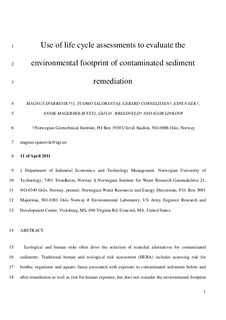| dc.contributor.author | Sparrevik, Lars Magnus | |
| dc.contributor.author | Saloranta, Tuomo | |
| dc.contributor.author | Cornelissen, Gerard | |
| dc.contributor.author | Eek, Espen | |
| dc.contributor.author | Fet, Annik Magerholm | |
| dc.contributor.author | Breedveld, Gijs D. | |
| dc.contributor.author | Linkov, Igor | |
| dc.date.accessioned | 2017-10-16T07:34:23Z | |
| dc.date.available | 2017-10-16T07:34:23Z | |
| dc.date.created | 2011-04-15T09:12:53Z | |
| dc.date.issued | 2011 | |
| dc.identifier.citation | Environmental Science and Technology. 2011, 45 (10), 4235-4241. | nb_NO |
| dc.identifier.issn | 0013-936X | |
| dc.identifier.uri | http://hdl.handle.net/11250/2460196 | |
| dc.description.abstract | Ecological and human risks often drive the selection of remedial alternatives for contaminated sediments. Traditional human and ecological risk assessment (HERA) includes assessing risk for benthic organisms and aquatic fauna associated with exposure to contaminated sediments before and after remediation as well as risk for human exposure but does not consider the environmental footprint associated with implementing remedial alternatives. Assessment of environmental effects over the whole life cycle (i.e., Life Cycle Assessment, LCA) could complement HERA and help in selecting the most appropriate sediment management alternative. Even though LCA has been developed and applied in multiple environmental management cases, applications to contaminated sediments and marine ecosystems are in general less frequent. This paper implements LCA methodology for the case of the polychlorinated dibenzo-p-dioxins and -furans (PCDD/F)-contaminated Grenland fjord in Norway. LCA was applied to investigate the environmental footprint of different active and passive thin-layer capping alternatives as compared to natural recovery. The results showed that capping was preferable to natural recovery when analysis is limited to effects related to the site contamination. Incorporation of impacts related to the use of resources and energy during the implementation of a thin layer cap increase the environmental footprint by over 1 order of magnitude, making capping inferior to the natural recovery alternative. Use of biomass-derived activated carbon, where carbon dioxide is sequestered during the production process, reduces the overall environmental impact to that of natural recovery. The results from this study show that LCA may be a valuable tool for assessing the environmental footprint of sediment remediation projects and for sustainable sediment management. | nb_NO |
| dc.language.iso | eng | nb_NO |
| dc.publisher | American Chemical Society | nb_NO |
| dc.title | Use of life cycle assessments to evaluate the environmental footprint of contaminated sediment remediation | nb_NO |
| dc.type | Journal article | nb_NO |
| dc.type | Peer reviewed | nb_NO |
| dc.description.version | acceptedVersion | nb_NO |
| dc.source.pagenumber | 4235-4241 | nb_NO |
| dc.source.volume | 45 | nb_NO |
| dc.source.journal | Environmental Science and Technology | nb_NO |
| dc.source.issue | 10 | nb_NO |
| dc.identifier.doi | 10.1021/es103925u | |
| dc.identifier.cristin | 802318 | |
| dc.relation.project | Norges forskningsråd: 188946 | nb_NO |
| dc.description.localcode | This journal is © The Royal Society of Chemistry 2011. This is the authors accepted and refereed manuscript to the article. | nb_NO |
| cristin.unitcode | 194,60,25,0 | |
| cristin.unitname | Institutt for industriell økonomi og teknologiledelse | |
| cristin.ispublished | true | |
| cristin.fulltext | postprint | |
| cristin.qualitycode | 2 | |
